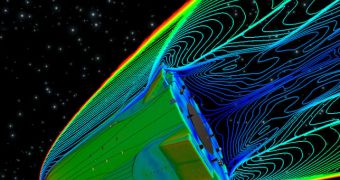Officials with the European Space Agency (ESA) announce that they have successfully completed the testing of a new and improved spacecraft control flap. What stands out about this component is that it will have to endure hypersonic falls through the atmosphere.
A space vehicle carrying the control flap is scheduled for first flight in 2012, and ESA needs to ensure that the component is within the required parameters by that time. To ensure the accuracy of their assessments, experts with the agency used the largest plasma wind tunnel in the world.
Representatives for ESA say that the spacecraft which will carry the flap will be called the European Experimental Reentry Testbed (EXPERT). It is designed like a blunt-nose capsule, that can fly at speeds of up to 5 kilometers per second during descent.
EXPERT will be encapsulated in the payload fairing of a Russian Volna rocket, and will be launched from aboard a submarine. Its primary purpose will be to gather data on atmospheric descent at hypersonic speeds.
The purpose of the newly-tested, experimental side flaps is to demonstrate that they can indeed stand the harsh conditions of such a fast reentry, and also that they can steer the spacecraft according to specifications uplinked by ground controllers.
If the 2012 tests are successful, then ESA will be able to continue developing the IXV Intermediate eXperimental Vehicle. The latter is currently tentatively set to launch as soon as 2013.
“This flap is fitted with a variety of instruments, including cameras, pressure monitors and an ultraviolet spectrometer to gather data during the hottest two minutes of Expert’s 15-minute flight,” EXPERT project scientist Jan Thoemel says.
“We needed to prove this instrumentation will indeed function as planned, and check our mathematical modeling was accurate,” he adds, explaining that this meant recreating the exact same extreme environment of atmospheric reentry on the ground.
For this purpose, ESA used the Capua, Naples-based Scirocco plasma wind tunnel in Italy. The installation is one of only a handful around the world that can handle such extreme testing.
“After years of preparation we performed four test runs on 13 April, comfortably exceeding the heat loads we anticipate the flap will encounter during its spaceflight aboard Expert,” Thoemel adds.
“Each test reached 1.75 times the flight heat load, amounting to seven times the flight heat load overall. Despite this, our instrumentation performed excellently, validating it for actual flight,” he explains.
“In the months that followed we’ve been comparing the test results to our software models to highlight any discrepancies, as a way of improving the computational fluid dynamics design tools used for EXPERT,” the project scientist concludes.

 14 DAY TRIAL //
14 DAY TRIAL //